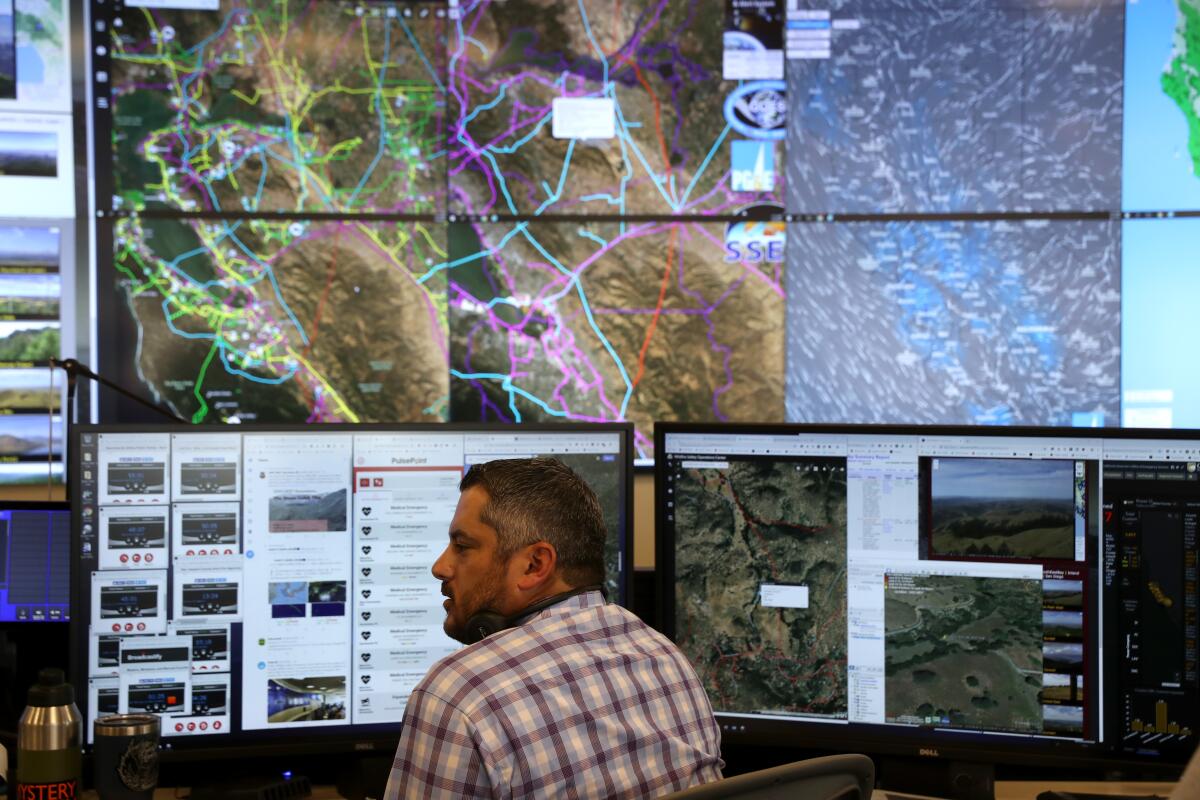PG&E’s blackouts were ‘not surgical by any stretch.’ Its systems may be to blame

- Share via
Pacific Gas & Electric Co. customers endured a sweeping power outage that darkened much of the state this week because the giant utility lags behind other California electricity providers in assessing wildfire risk and deploying systems to target shutdowns based on the most severe wildfire risks.
San Francisco-based PG&E is struggling to catch up with San Diego Gas & Electric Co., which has become California’s recognized leader in forecasting fire danger, tailoring narrow outages for the most endangered neighborhoods and communicating the emergencies with the public, a top state regulator said.
“Those have been three pillars of success for SDG&E, and they are currently sources of failure for PG&E,” said Elizaveta Malashenko, deputy executive director for safety policy at the California Public Utilities Commission.
A forecast of high winds and increased fire danger led PG&E to cut power Wednesday to about 730,000 customers across 34 counties, stretching from Humboldt County in the north to Kern County in the south. About 135,000 customers had their electricity restored by 11 a.m. Thursday, while nearly 600,000 more waited. The utility hoped to have power back on to the entire region by the end of the weekend.
“Their shut-off strategy, hitting 800,000 customers, is not surgical by any stretch,” said Mark Toney, executive director of the Utility Reform Network, a consumer watchdog group. “It’s like, they’ll do whatever they feel like. And in this case it was a total overreaction. The wind was nowhere close to what was predicted.”
Many PG&E customers were also outraged Wednesday. “It’s not fair to anybody,” said Michael Welcome, 45, of Clear Lake. “They are putting us back in the Stone Age. You can’t think of something else to do?”
PG&E executives said they had heard the complaints from customers and elected officials but defended the shut-off as a necessary precaution.
“We appreciate the significant impact that turning off power has for our customers and the state,” said PG&E spokesman Paul Doherty, “and we absolutely share the state’s focus on reducing the impact of wildfires. That’s why we took this action. And we did not take it lightly.”
During the power cuts, rural residents in Lake County struggled with basic necessities, such as powering medical devices and keeping food fresh. There were few services to help them.
San Diego revamped its fire-preparedness systems after the 2007 Witch fire, which destroyed more than 1,000 homes and killed two people. SDG&E relocated some power lines underground, insulated others and created microgrids that allowed it to shut off power in neighborhoods at highest fire risk.
The San Diego utility also has the advantage of serving a much smaller area than PG&E. It has 3.6 million customers spread over 4,100 square miles, but PG&E serves 16 million customers in a 70,000-square-mile stretch of the state’s midsection.
San Diego operates a “networked” grid of major transmission lines, smaller distribution lines and circuits that often allows more than one path in and out of circuits, which serve anywhere from 1,000 to 7,000 customers. PG&E, in contrast, runs a “radial” system, in which lone power lines stretch — often over extremely long distances — into and out of service areas.
SDG&E has ordered 13 “public safety power shut-offs” since 2013. The largest, in November, turned off electricity for 23,000 customers, with a total of 52,000 temporarily losing power over those six years. A couple of the shutdowns affected just one or two customers. “That might be one testament to how granular we can get,” said Allison Torres, a spokeswoman for the utility.
During those shutdowns, the San Diego operator never cut the power delivered through the large transmission lines that bring electricity to entire regions. It focused instead on the distribution lines that serve neighborhoods.
Even at the neighborhood level, SDG&E two years ago began to target shut-offs even more precisely, by using “sectionalizing” devices. The equipment allows electricity to keep flowing to some customers while others on the same circuit are cut off. “So we are surgically able to shut them off, as opposed to shutting off a whole community,” Torres said.
PG&E, in contrast, shut down nearly 100 transmission lines during the current power reduction, according to the California Public Utilities Commission. Those major arteries stretched across 2,500 miles and linked to an additional 25,000 miles of distribution lines that also lost power — more than enough to wrap once around Earth.
“If you don’t have enough switches and the flexibility in your network configuration, you have no choice then [but] to just shut off a wide area of your customers,” said Hamidreza Nazaripouya, an assistant professional researcher at UC Riverside’s Winston Chung Global Energy Center.
PG&E’s Doherty acknowledged the challenge of precisely targeting planned shutdowns.
“The interconnected nature of the grid is why you can have instances where people who aren’t in high fire-risk areas might have their power shut off,” Doherty said. “A line might run through a high-risk area and others not in that district, and it impacts those customers, as well.”
And every inch of those lines is scheduled for inspection to make sure there is no damage that would prevent lines from being re-electrified. Doherty said initial reports suggest that at least some of the lines suffered damage from windblown trees or vegetation.
Unlike the other big utilities, PG&E has filed for bankruptcy protection, largely because of liabilities incurred from last year’s Camp fire and the 2017 wine country fires. It has also admitted in federal court that its equipment probably caused 10 wildfires this year in Northern and Central California.
Some legal experts and consumer advocates, such as Toney, have questioned whether the utility is overreacting now to avoid further liabilities.
San Diego’s head start on fire-safe electrical operations begins with its weather and risk assessment program, according to Public Utilities Commission officials. The utility has 190 weather-monitoring stations and employs five full-time meteorologists — some with fire science backgrounds — to assess the data.
PG&E, in contrast, had virtually no weather-reporting outposts before the 2017 wildfires that burned vast stretches of wine country. It has since built 360 weather stations to enhance its data collection. “There is definitely a lot of progress being made, but it wasn’t happening as fast as we would have needed, going into this fire season,” the PUC’s Malashenko said.
In a similar vein, PG&E has made progress on revamping its grid to allow more sectionalizing, so power can be cut more incrementally, Malashenko said. “But there is a lot of work to be done and we are not where we want it to be,” the regulator said. “It’s a major challenge.”
Finally, the state’s biggest investor-owned utility needs to restore the trust of customers after years of reports of substandard service, poor communication and responsibility for wildfires that have burned thousands of homes and killed dozens.
“In Northern California, they are starting at such a low level of trust,” Malashenko said. “They have very fractured relationships and … no reserves of trust.”
Gov. Gavin Newsom slammed the utility’s tenuous relationship with its customers at a news conference Thursday afternoon.
“It’s decisions that were not made that have led to this moment in PG&E’s history and the state of California as it relates to our major investor-owned utility,” Newsom said.
PG&E Chief Executive Bill Johnson, at an earlier news conference Thursday, said that safety was the goal of this week’s shutdown and that by that measure, it was a success.
“We faced a choice between a hardship for everyone and safety, and we chose safety,” said Johnson, who joined the company in April. “We’ll likely have to make this kind of decision again in the future.”
PUC officials said that Southern California Edison has made more progress than PG&E on wildfire readiness.
The utility reports purchasing two supercomputers for $4 million and installing 170 weather sensors to enhance its fire-prediction capabilities. Edison anticipates it will be able to monitor 90% of its high-risk fire areas through cameras by the end of the year.
Its assessment and response abilities are improved, but it has more work to do, said Malashenko, calling fire safety improvements “a significant challenge for Southern California Edison.”
“Both of the larger electric operators continue to look south for lessons, she said, adding, “Their wildfire mitigation plans reflect them trying to catch up with SDG&E.”
Times staff writer Anita Chabria contributed to this report.
More to Read
Sign up for Essential California
The most important California stories and recommendations in your inbox every morning.
You may occasionally receive promotional content from the Los Angeles Times.














